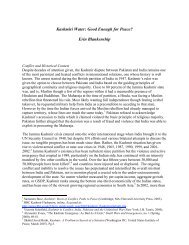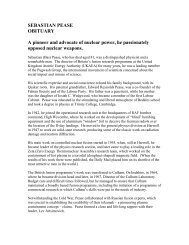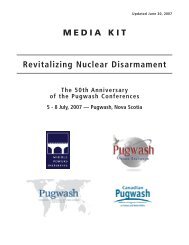Eliminating Stockpiles of Highly Enriched Uranium - Pugwash ...
Eliminating Stockpiles of Highly Enriched Uranium - Pugwash ...
Eliminating Stockpiles of Highly Enriched Uranium - Pugwash ...
Create successful ePaper yourself
Turn your PDF publications into a flip-book with our unique Google optimized e-Paper software.
Chapter 1: Introduction<br />
The end <strong>of</strong> the Cold War has dramatically reduced the risk <strong>of</strong> a nuclear war. Yet, the<br />
legacy from this era continues to pose challenges to international security. There are<br />
more than 30 000 nuclear warheads either operational or in reserve stocks and<br />
stockpiles amounting to millions <strong>of</strong> kilograms <strong>of</strong> weapons-grade nuclear material<br />
(both HEU and plutonium). The prospects <strong>of</strong> both horizontal and vertical nuclear<br />
proliferation have not ceased to exist. 1 Moreover, this situation has greatly<br />
accentuated a new nuclear threat: The possibility <strong>of</strong> terrorist uses <strong>of</strong> crude nuclear<br />
explosive devices.<br />
Renewed attention should be directed toward diminishing these threats<br />
through joint international efforts to secure, reduce and eliminate the core ingredients<br />
<strong>of</strong> any nuclear device: highly enriched uranium (HEU) and plutonium. Specifically,<br />
the objective <strong>of</strong> this study is to identify ways and means to reduce the HEU threats –<br />
through the active engagement <strong>of</strong> new actors, the European Union, or other singular<br />
European states, possibly in the context <strong>of</strong> the G8 Global Partnership Against the<br />
Spread <strong>of</strong> Weapons and Materials <strong>of</strong> Mass Destruction.<br />
On a global scale, the arms race has led to the production <strong>of</strong> large quantities <strong>of</strong><br />
HEU that far exceed the stocks <strong>of</strong> weapons-usable plutonium. Due to the fact that<br />
HEU has mainly been produced for military purposes in nuclear weapon states, only a<br />
minuscule amount (roughly 1%) <strong>of</strong> all HEU stocks come under international control<br />
<strong>of</strong> the International Atomic Energy Agency (IAEA). There have been several cases <strong>of</strong><br />
theft <strong>of</strong> kilogram quantities <strong>of</strong> this weapons-useable material. 2<br />
The largest amount <strong>of</strong> “unirradiated HEU”, (i.e. “fresh HEU, or HEU that has<br />
not been burned in a reactor) is found in Russia and hence the focus <strong>of</strong> this study. The<br />
exact figure is not known. Un<strong>of</strong>ficial estimates vary between slightly above 1000 to<br />
1500 tons – amounting to tens <strong>of</strong> thousands <strong>of</strong> nuclear warheads. Currently, less than<br />
40 % <strong>of</strong> the material potentially vulnerable to theft has been covered by physical<br />
security upgrades funded by the US. 3 Less than one sixth <strong>of</strong> Russia’s stockpile <strong>of</strong><br />
highly enriched uranium has been eliminated under a US–Russian agreement.<br />
According to this US-Russian HEU agreement, 500 tonnes <strong>of</strong> HEU will be<br />
transformed to low enriched uranium and marketed in the US and burned in<br />
commercial nuclear power plants. After initial difficulties, the HEU elimination<br />
scheme is now back on track. 4 However, even after being fully implemented by 2013,<br />
the deal will cover less than 40% <strong>of</strong> existing Russian HEU stocks. Additional HEU<br />
1 Canberra Commission on the Elimination <strong>of</strong> Nuclear Weapons, 1996.<br />
http://www.dfat.gov.au/cc/cchome.html; Joseph Cirincione, “Nukes Endanger Asia's Future”, Los<br />
Angeles Times, September 29, 2003; Sarah Diehl/James Clay Moltz, Nuclear Weapons and<br />
Nonproliferation, ABC-CLIO Inc., Santa Barbara, 2002.<br />
Monday, September 29, 2003<br />
2 Bunn, Matthew, Anthony Wier, and John P. Holdren. Controlling Nuclear Warheads and Materials: A<br />
Report Card and Action Plan. Washington, D.C.: Nuclear Threat Initiative and the Project on<br />
Managing the Atom, Harvard University, March 2003; Lyudmila Zaitseva and Friederich Steinhausler,<br />
"Illicit Trafficking <strong>of</strong> Weapons-Usable Nuclear Material: Facts and Uncertainties", Physics and Society<br />
vol. 33, no. 1, pp. 5-8, January 2004; http://www.nti.org/e_research/cnwm/overview/cnwm_home.asp<br />
3 General Accounting Office, “Weapons <strong>of</strong> Mass Destruction. Additional Russian Cooperation Needed<br />
to Facilitate U.S. Efforts to Improve Security at Russian Sites”, GAO-03-482, submitted to<br />
Subcommittee on Financial Management, the Budget, and International Security, March 2003,<br />
www.gao.gov/cgi-bin/getrpt?GAO-03-482.<br />
4 Nigel Hunt, “Russian nuclear warheads help to power U.S.”, Feature, 14 March 2004.<br />
8







